北师大版(2019)选择性必修第四册 Unit10 Connections Lesson1 How Closely Connected Are We?公开课课件(共55张PPT)
文档属性
| 名称 | 北师大版(2019)选择性必修第四册 Unit10 Connections Lesson1 How Closely Connected Are We?公开课课件(共55张PPT) | 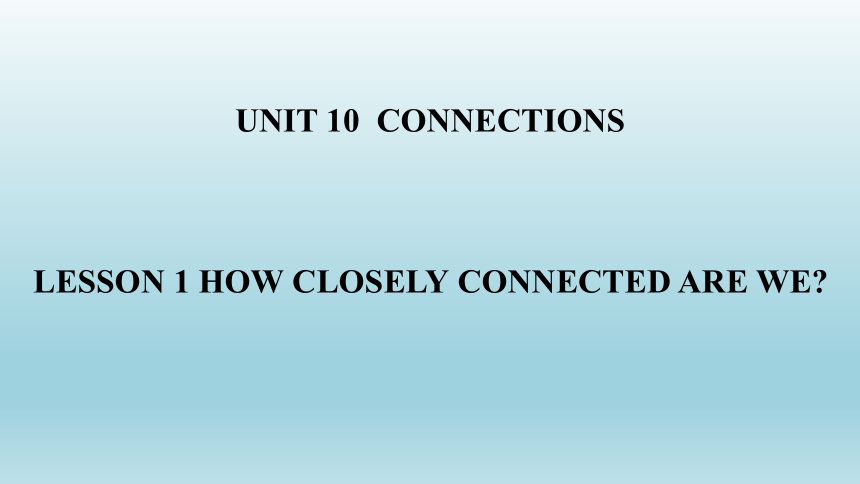 | |
| 格式 | pptx | ||
| 文件大小 | 819.2KB | ||
| 资源类型 | 教案 | ||
| 版本资源 | 北师大版(2019) | ||
| 科目 | 英语 | ||
| 更新时间 | 2023-03-17 20:18:37 | ||
图片预览



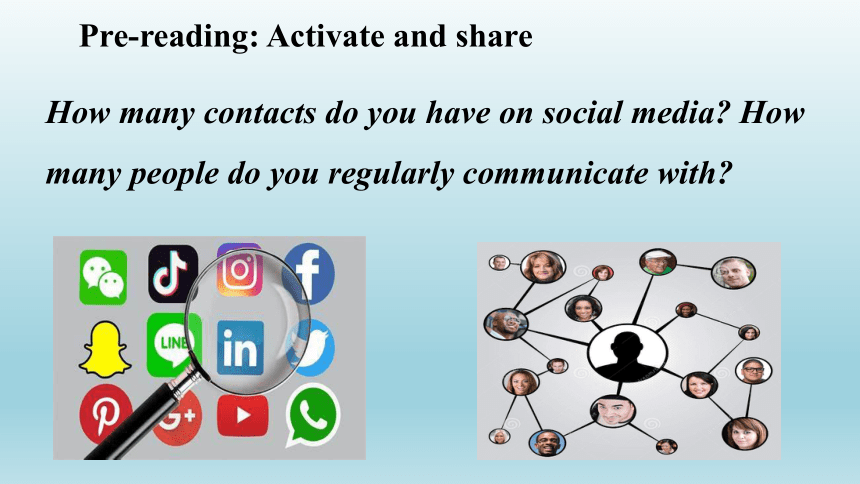

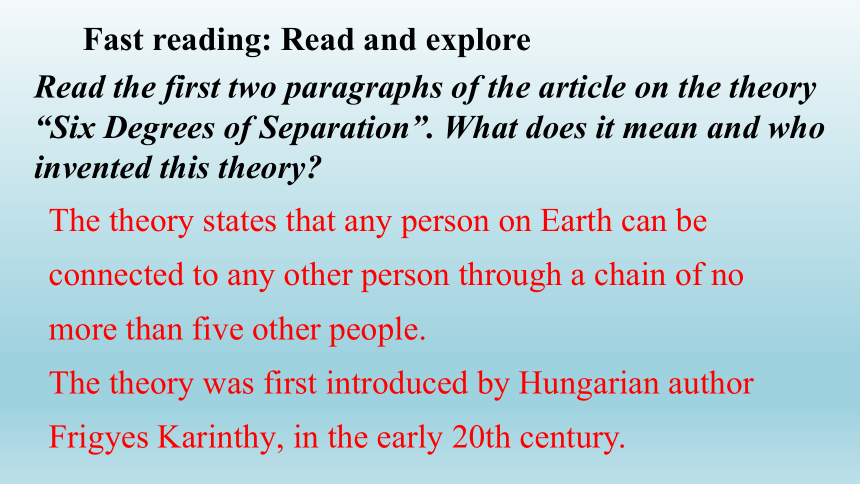


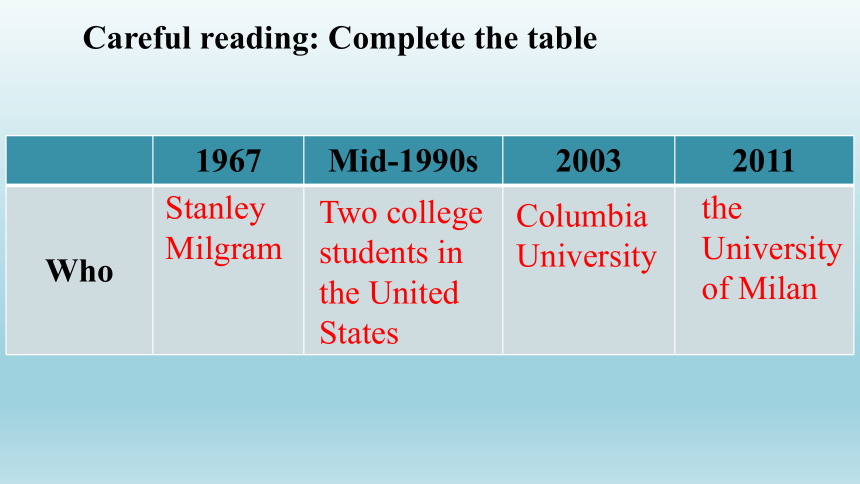
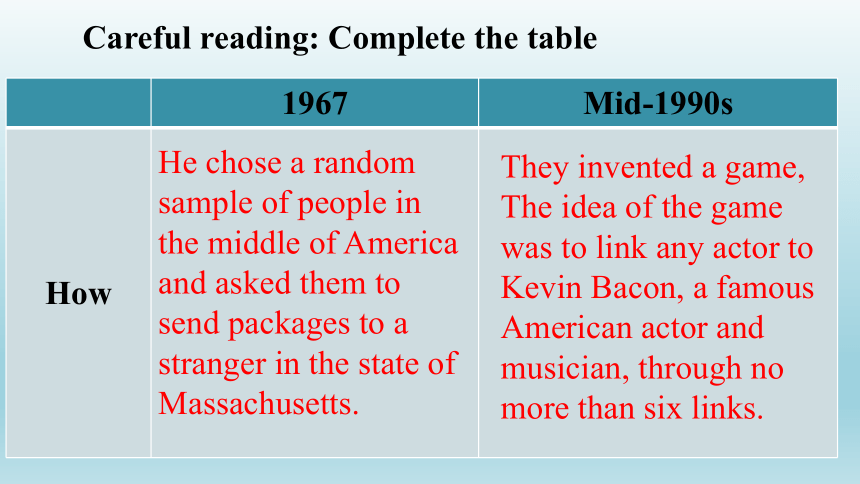

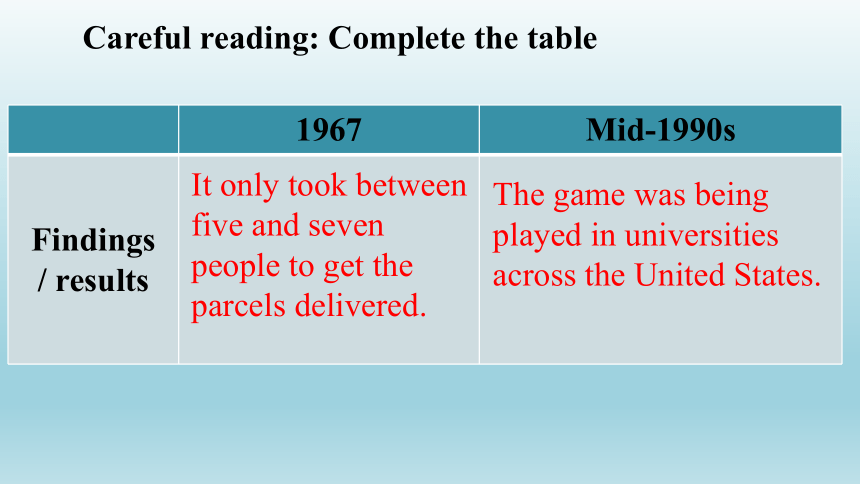
文档简介
(共55张PPT)
UNIT 10 CONNECTIONS
LESSON 1 HOW CLOSELY CONNECTED ARE WE
Pre-reading
I
Post-reading
IV
Fast reading
II
Language and grammar
V
III
Careful reading
Ⅵ
Homework
目录页
contents
Ⅰ
Pre-reading
Pre-reading: Activate and share
How many contacts do you have on social media How many people do you regularly communicate with
Ⅱ
Fast reading
Read the first two paragraphs of the article on the theory “Six Degrees of Separation”. What does it mean and who invented this theory
The theory states that any person on Earth can be connected to any other person through a chain of no more than five other people.
The theory was first introduced by Hungarian author Frigyes Karinthy, in the early 20th century.
Fast reading: Read and explore
Ⅲ
Careful reading
1967 Mid-1990s 2003 2011
Who
How
Findings / results
Careful reading: Complete the table
1967 Mid-1990s 2003 2011
Who
Careful reading: Complete the table
Stanley Milgram
Two college students in the United States
the University of Milan
Columbia University
1967 Mid-1990s
How
Careful reading: Complete the table
He chose a random sample of people in the middle of America and asked them to send packages to a stranger in the state of Massachusetts.
They invented a game, The idea of the game was to link any actor to Kevin Bacon, a famous American actor and musician, through no more than six links.
2003 2011
How
Careful reading: Complete the table
“Columbia Small-world Project”: Columbia University tried to recreate Milgram’s experiment on the Internet. The experiment involved 24,163 email chains with 18 target people in 13 different countries.
The experiment analysed the relationship between 721 million social media users.
1967 Mid-1990s
Findings / results
Careful reading: Complete the table
It only took between five and seven people to get the parcels delivered.
The game was being played in universities across the United States.
2003 2011
Findings / results
Careful reading: Complete the table
The results confirmed that the average number of links in the chain was six.
92% were connected by only four stages.
“Six Degrees of Separation”
What does it mean
When did the term first appear
What happened in the 1950s
What did Stanley Milgram do
Careful reading
Explain the “ Six Degrees of Separation” theory.
“Six Degrees of Separation”
How many people did it take for the parcel to reach the right person in Milgram’s experiment
How did it influence the entertainment industry
What is the “Columbia Small-world Project”
What was the result of the University of Milan’s research
Careful reading
What does it mean
Careful reading
Explain the “ Six Degrees of Separation” theory.
Meaning: It refers to the theory that any person on Earth can be connected to any person through a chain of no more than five other people.
When did the term first appear
The first appearance: In the 1920s.
Careful reading
Explain the “ Six Degrees of Separation” theory.
What happened in the 1950s
In the 1950s, scientist made an attempt to prove the theory.
What did Stanley Milgram do
In 1967, Stanley Milgram tried using a new method to test the theory called “small-world problem”.
Careful reading
Explain the “ Six Degrees of Separation” theory.
What is the “Columbia Small-world Project”
What was the result of the University of Milan’s research
“Columbia Small-world Project”: Columbia University tried to recreate Milgram experiment on the Internet.
An experiment at University of Milan: 92% of media users were connected by only four stages, or five degrees of separation.
Ⅳ
Post-reading
Why did Milgram and Columbia University both label their experiments “Small-world”
Post-reading
Group Work Think and share. (Ex5)
Because they believed that any person on Earth couldbe connected to any other person through a chain of
no more than five other people. In this sense the worldis small.
Post-reading
Group Work Think and share. (Ex5)
2. Why do you think people study how people are connected
Probably people want to study the structures of human society, the rules of human social activities, and how people are connected with each other.
HOW CLOSELY CONNECTED ARE WE
Post-reading: Summary
P1 Lead-in
Post-reading: Summary
P2-6 The Development of the theory
(Para. 2) Karinthy first put forward the concept
(Para. 3) different attempts to prove and test the theory
(Para. 4) reappearance of the theory
(Para. 5) “Columbia Small-world Project”
(Para. 6) an experiment at the University of Milan
Introduce the theory of “Six Degrees of Separation”.
P7 Conclusion
We might be connected to someone we don’t know.
Ⅴ
Language and grammar
1. In 1967, __________ Stanley Milgram did an experiment to find out how many degrees of separation there were between strangers in different parts of America.
2. All of the ________ in Milgram’s experiment were delivered to the right people after passing through the hands of between five and seven people.
random sociologist network publish package chain
Focus on Language: Important words
sociologist
packages
3. The results of Milgram’s experiment _____________ in the magazine Psychology Today.
4. The results of the “Columbia Small-world Project” confirmed that the average number of links in the _____ was six.
random sociologist network publish package chain
were published
chain
Focus on Language: Important words
5. People doing experiments into “Six Degrees of Separation” usually choose a _______ sample of people to take part to make the results more reliable.
6. Recently, creating and growing your social ________ has become more important than ever before due to the growth of social media.
random sociologist network publish package chain
random
network
Focus on Language: Important words
Focus on Language: Important sentences
Research shows the average person only has regular communication with between seven and fifteen people, and that most of our communication is in fact with five to ten people who are closest to us.
Page8
研究表明,普通人只与 7 至 15个人经常保持联系,而且其中大部分的交流实际上只发生在 5 到 10 个亲近的人身上。
Research shows the average person only has regular communication with between seven and fifteen people, and that most of our communication is in fact with five to ten people who are closest to us.
Page8
Research shows (that) the average person … and fifteen people 此句为省略了 that 的宾语从句
Focus on Language: Important sentences
Research shows the average person only has regular communication with between seven and fifteen people, and that most of our communication is in fact with five to ten people who are closest to us.
Page8
and that most of our communication … are closest to us 此句为 that 引导的宾语从句;
who are closest to us 此句为 who 引导的定语从句
Focus on Language: Important sentences
Research shows the average person only has regular communication with between seven and fifteen people, and that most of our communication is in fact with five to ten people who are closest to us.
Page8
注意:本句 and 并列了两个宾语从句,当一个句子有多个并列的宾语从句,第一个宾语从句的引导词 that 可省略,后面宾语从句的引导词 that 不可以省略。
Focus on Language: Important sentences
The Hungarian author Frigyes Karinthy published a book called Everything is Different in 1929, in which he introduced the idea of friendship networks and his ideas influenced many of our early impressions of social networks.
Page8
匈牙利作家弗里吉斯·考林蒂于 1929 年出版了《一切皆不同》这本书,在书中他介绍了关系网的概念,并且他的观点影响了我们早期很多对于社会网的设想。
Focus on Language: Important sentences
in which … social networks 为介词加关系代词引导的定语从句。
Page8
The Hungarian author Frigyes Karinthy published a book called Everything is Different in 1929, in which he introduced the idea of friendship networks and his ideas influenced many of our early impressions of social networks.
Focus on Language: Important sentences
impression: leave / make an impression on sb
impress v 使钦佩;给……留下深刻印象
be impressed with / by / at … 对……印象深刻
Page8
The Hungarian author Frigyes Karinthy published a book called Everything is Different in 1929, in which he introduced the idea of friendship networks and his ideas influenced many of our early impressions of social networks.
Focus on Language: Important sentences
Amazingly, it only took between five and seven people to get the parcels delivered, and once released, the results were published in the bimonthly magazine Psychology Today.
Page9
令人惊奇的是,这些包裹只需要经五到七个人就能够送达,此结果一经发布,就发布在了双月刊《今日心理学》上。
Focus on Language: Important sentences
Amazingly, it only took between five and seven people to get the parcels delivered, and once released, the results were published in the bimonthly magazine Psychology Today.
Page9
get sb / sth done 使某人 / 某物被……
Once 引导状语从句的省略,完整形式是 once the results were released
Focus on Language: Important sentences
状语从句的省略
状语从句同时具备下列两个条件:
① 主句和从句的主语一致;
② 从句谓语动词是 be 的某种形式。满足以上两个条件,从句中的主语和 be 动词常可省略。
Focus on Language: Important sentences
___________________________ (在北京旅游的时候), I paid a visit to the Summer Palace.
When _____ (ask) for his views about his teaching job, Philip said he found it very interesting and rewarding.
______________ (除非修理), the machine is of no use.
4. _______________________ (要是给更多的关注), the
boy could have turned out better.
When / While visiting in Beijing
asked
Unless repaired
If given more attention to
Focus on Language: Exercises
The television series Lost also explored the idea of “Six Degrees of Separation”, as almost all the characters had randomly met each other, or had met someone the other characters knew, before they were all in the same plane crash.
Page9
电视剧《迷失》也探讨了“六度分隔”理论,因为剧中同一架失事飞机上几乎所有角色之前都曾偶遇,或者曾遇到过其他角色认识的人。
Focus on Language: Important sentences
As 引导原因状语从句,其中 or 连接了两个谓语动词;someone 后面是省略了关系代词的定语从句;
before 引导了时间状语从句。
Page9
Focus on Language: Important sentences
The television series Lost also explored the idea of “Six Degrees of Separation”, as almost all the characters had randomly met each other, or had met someone the other characters knew, before they were all in the same plane crash.
As 做连词的用法:
引导时间状语从句。与 while 意义相近,强调两个动作同时发生;或某事一发生,另一事立刻发生。
① He shouted aloud as he ran along.
② I was startled as he opened the door.
③ We get wiser as we get older.
Focus on Language: Important sentences
As 做连词的用法:
2. 引导原因状语从句,与 because 的用法相近。
① As it was getting very late, we soon turned back.
② We must stop writing now, as I have rather a lot of work to do.
Focus on Language: Important sentences
As 做连词的用法:
3. 引导方式状语从句,作“正如,好像,按照”解。主要的句式有 as if / as though / just a / just as … as。
① When at Rome, do as Romans do.
② We do farm work as the old peasant teaches us.
Focus on Language: Words and sentences
As 做连词的用法:
4. 引导让步状语从句;作“虽然,尽管”解。这时从句常用倒状语序,即把从句中的表语,状语或动词原形放在 as 之前。
① Child as she is, she knows a lot.
② Busy as he is, he insists on studying.
③ Try as he might, Tom could not get out of the difficulties.
Focus on Language: Words and sentences
Read the sentences. Underline the passive forms. What tense is used in each sentence
The concept was first talked about as long ago as in the 1920s.
In the 1950s, an attempt was made by two scientists to prove the theory mathematically.
Focus on Grammar: Passive Forms in the Past
3. Once the parcel had been received by this person, he /she would send the parcel onto a contact of theirs until the parcel could be personally delivered to the correct person.
4. Its name was used as the title of a play and then a film.
5. Soon the game was being played in universities across the United States.
Focus on Grammar: Passive Forms in the Past
Focus on Grammar: Passive Forms in the Past
一般过去时被动语态
肯定:
S.+ was / were done …
否定:
S. + was / were not done …
一般过去时的被动语态表示在过去时间内某个动作被做。
Focus on Grammar: Passive Forms in the Past
过去进行时的被动语态
肯定:
S. + was / were doing …
否定:
S. + was / were not being done …
过去进行时的被动语态强调在过去某段时间内正在进行的被动动作。
Focus on Grammar: Passive Forms in the Past
过去完成时的被动语态
肯定:
S. + had been done …
否定:
S. + hadn’t been done …
过去完成时的被动语态强调相对于过去某个时刻来说已经被完成的动作。
We 1. _________ (give) the task of finding out whether the “Six Degrees of Separation” theory worked at our school. We 2. _________ (tell) about the “Small-world” experiment in the United States, where packages 3. _____________ (send) from one person to another with the aim of getting it to a stranger in the end. While the idea behind this experiment 4. ___________________ (discuss) in our group, it 5. ______________ (suggest) to us by our teacher that we try something similar. So we did. We couldn’t send parcels, but we could send letters.
were given
were told
had been sent
was being discussed
was suggested
Focus on Grammar: Exercises
Ten volunteers 6. ____________ (choose) to take part and they 7. ___________ (ask) to write a letter of introduction to another person in the school that they didn’t know and then to choose someone who they thought 8. ______________ (connect) to that person to give it to. After all the letters 9. _______________ (exchange) several times, seven out of the ten target people did receive their letters with chains of five or six people in each case! We think this means that our experiment was a success and it supports the theory.
were chosen
were asked
was connected
were exchanged
Focus on Grammar: Exercises
1. Nearly 500,00 high-quality digital photographs _____
__________ (produce) in 2019.
2. It _________ (build) originally to protect the city in the
Tang dynasty and has now been completely restored.
3. I was sent to the village last month to see how the
development plan ________________ (carry) out in the
past two years.
were
had been carried
was built
Focus on Grammar: Passive Forms in the Past
produced
4. It was the first time that the meeting ____________ (hold)
in this small town.
5. He was _______________ (interview) by our headmaster
then.
being interviewed
had been held
Focus on Grammar: Passive Forms in the Past
VI
Homework
Homework
Discuss and decide what experiment you can carry out to find out how many degrees of separation there are between people who don’t know each other.
Consider:
How many people will participate in the experiment
How will you find out the results of the experiment
UNIT 10 CONNECTIONS
LESSON 1 HOW CLOSELY CONNECTED ARE WE
Pre-reading
I
Post-reading
IV
Fast reading
II
Language and grammar
V
III
Careful reading
Ⅵ
Homework
目录页
contents
Ⅰ
Pre-reading
Pre-reading: Activate and share
How many contacts do you have on social media How many people do you regularly communicate with
Ⅱ
Fast reading
Read the first two paragraphs of the article on the theory “Six Degrees of Separation”. What does it mean and who invented this theory
The theory states that any person on Earth can be connected to any other person through a chain of no more than five other people.
The theory was first introduced by Hungarian author Frigyes Karinthy, in the early 20th century.
Fast reading: Read and explore
Ⅲ
Careful reading
1967 Mid-1990s 2003 2011
Who
How
Findings / results
Careful reading: Complete the table
1967 Mid-1990s 2003 2011
Who
Careful reading: Complete the table
Stanley Milgram
Two college students in the United States
the University of Milan
Columbia University
1967 Mid-1990s
How
Careful reading: Complete the table
He chose a random sample of people in the middle of America and asked them to send packages to a stranger in the state of Massachusetts.
They invented a game, The idea of the game was to link any actor to Kevin Bacon, a famous American actor and musician, through no more than six links.
2003 2011
How
Careful reading: Complete the table
“Columbia Small-world Project”: Columbia University tried to recreate Milgram’s experiment on the Internet. The experiment involved 24,163 email chains with 18 target people in 13 different countries.
The experiment analysed the relationship between 721 million social media users.
1967 Mid-1990s
Findings / results
Careful reading: Complete the table
It only took between five and seven people to get the parcels delivered.
The game was being played in universities across the United States.
2003 2011
Findings / results
Careful reading: Complete the table
The results confirmed that the average number of links in the chain was six.
92% were connected by only four stages.
“Six Degrees of Separation”
What does it mean
When did the term first appear
What happened in the 1950s
What did Stanley Milgram do
Careful reading
Explain the “ Six Degrees of Separation” theory.
“Six Degrees of Separation”
How many people did it take for the parcel to reach the right person in Milgram’s experiment
How did it influence the entertainment industry
What is the “Columbia Small-world Project”
What was the result of the University of Milan’s research
Careful reading
What does it mean
Careful reading
Explain the “ Six Degrees of Separation” theory.
Meaning: It refers to the theory that any person on Earth can be connected to any person through a chain of no more than five other people.
When did the term first appear
The first appearance: In the 1920s.
Careful reading
Explain the “ Six Degrees of Separation” theory.
What happened in the 1950s
In the 1950s, scientist made an attempt to prove the theory.
What did Stanley Milgram do
In 1967, Stanley Milgram tried using a new method to test the theory called “small-world problem”.
Careful reading
Explain the “ Six Degrees of Separation” theory.
What is the “Columbia Small-world Project”
What was the result of the University of Milan’s research
“Columbia Small-world Project”: Columbia University tried to recreate Milgram experiment on the Internet.
An experiment at University of Milan: 92% of media users were connected by only four stages, or five degrees of separation.
Ⅳ
Post-reading
Why did Milgram and Columbia University both label their experiments “Small-world”
Post-reading
Group Work Think and share. (Ex5)
Because they believed that any person on Earth couldbe connected to any other person through a chain of
no more than five other people. In this sense the worldis small.
Post-reading
Group Work Think and share. (Ex5)
2. Why do you think people study how people are connected
Probably people want to study the structures of human society, the rules of human social activities, and how people are connected with each other.
HOW CLOSELY CONNECTED ARE WE
Post-reading: Summary
P1 Lead-in
Post-reading: Summary
P2-6 The Development of the theory
(Para. 2) Karinthy first put forward the concept
(Para. 3) different attempts to prove and test the theory
(Para. 4) reappearance of the theory
(Para. 5) “Columbia Small-world Project”
(Para. 6) an experiment at the University of Milan
Introduce the theory of “Six Degrees of Separation”.
P7 Conclusion
We might be connected to someone we don’t know.
Ⅴ
Language and grammar
1. In 1967, __________ Stanley Milgram did an experiment to find out how many degrees of separation there were between strangers in different parts of America.
2. All of the ________ in Milgram’s experiment were delivered to the right people after passing through the hands of between five and seven people.
random sociologist network publish package chain
Focus on Language: Important words
sociologist
packages
3. The results of Milgram’s experiment _____________ in the magazine Psychology Today.
4. The results of the “Columbia Small-world Project” confirmed that the average number of links in the _____ was six.
random sociologist network publish package chain
were published
chain
Focus on Language: Important words
5. People doing experiments into “Six Degrees of Separation” usually choose a _______ sample of people to take part to make the results more reliable.
6. Recently, creating and growing your social ________ has become more important than ever before due to the growth of social media.
random sociologist network publish package chain
random
network
Focus on Language: Important words
Focus on Language: Important sentences
Research shows the average person only has regular communication with between seven and fifteen people, and that most of our communication is in fact with five to ten people who are closest to us.
Page8
研究表明,普通人只与 7 至 15个人经常保持联系,而且其中大部分的交流实际上只发生在 5 到 10 个亲近的人身上。
Research shows the average person only has regular communication with between seven and fifteen people, and that most of our communication is in fact with five to ten people who are closest to us.
Page8
Research shows (that) the average person … and fifteen people 此句为省略了 that 的宾语从句
Focus on Language: Important sentences
Research shows the average person only has regular communication with between seven and fifteen people, and that most of our communication is in fact with five to ten people who are closest to us.
Page8
and that most of our communication … are closest to us 此句为 that 引导的宾语从句;
who are closest to us 此句为 who 引导的定语从句
Focus on Language: Important sentences
Research shows the average person only has regular communication with between seven and fifteen people, and that most of our communication is in fact with five to ten people who are closest to us.
Page8
注意:本句 and 并列了两个宾语从句,当一个句子有多个并列的宾语从句,第一个宾语从句的引导词 that 可省略,后面宾语从句的引导词 that 不可以省略。
Focus on Language: Important sentences
The Hungarian author Frigyes Karinthy published a book called Everything is Different in 1929, in which he introduced the idea of friendship networks and his ideas influenced many of our early impressions of social networks.
Page8
匈牙利作家弗里吉斯·考林蒂于 1929 年出版了《一切皆不同》这本书,在书中他介绍了关系网的概念,并且他的观点影响了我们早期很多对于社会网的设想。
Focus on Language: Important sentences
in which … social networks 为介词加关系代词引导的定语从句。
Page8
The Hungarian author Frigyes Karinthy published a book called Everything is Different in 1929, in which he introduced the idea of friendship networks and his ideas influenced many of our early impressions of social networks.
Focus on Language: Important sentences
impression: leave / make an impression on sb
impress v 使钦佩;给……留下深刻印象
be impressed with / by / at … 对……印象深刻
Page8
The Hungarian author Frigyes Karinthy published a book called Everything is Different in 1929, in which he introduced the idea of friendship networks and his ideas influenced many of our early impressions of social networks.
Focus on Language: Important sentences
Amazingly, it only took between five and seven people to get the parcels delivered, and once released, the results were published in the bimonthly magazine Psychology Today.
Page9
令人惊奇的是,这些包裹只需要经五到七个人就能够送达,此结果一经发布,就发布在了双月刊《今日心理学》上。
Focus on Language: Important sentences
Amazingly, it only took between five and seven people to get the parcels delivered, and once released, the results were published in the bimonthly magazine Psychology Today.
Page9
get sb / sth done 使某人 / 某物被……
Once 引导状语从句的省略,完整形式是 once the results were released
Focus on Language: Important sentences
状语从句的省略
状语从句同时具备下列两个条件:
① 主句和从句的主语一致;
② 从句谓语动词是 be 的某种形式。满足以上两个条件,从句中的主语和 be 动词常可省略。
Focus on Language: Important sentences
___________________________ (在北京旅游的时候), I paid a visit to the Summer Palace.
When _____ (ask) for his views about his teaching job, Philip said he found it very interesting and rewarding.
______________ (除非修理), the machine is of no use.
4. _______________________ (要是给更多的关注), the
boy could have turned out better.
When / While visiting in Beijing
asked
Unless repaired
If given more attention to
Focus on Language: Exercises
The television series Lost also explored the idea of “Six Degrees of Separation”, as almost all the characters had randomly met each other, or had met someone the other characters knew, before they were all in the same plane crash.
Page9
电视剧《迷失》也探讨了“六度分隔”理论,因为剧中同一架失事飞机上几乎所有角色之前都曾偶遇,或者曾遇到过其他角色认识的人。
Focus on Language: Important sentences
As 引导原因状语从句,其中 or 连接了两个谓语动词;someone 后面是省略了关系代词的定语从句;
before 引导了时间状语从句。
Page9
Focus on Language: Important sentences
The television series Lost also explored the idea of “Six Degrees of Separation”, as almost all the characters had randomly met each other, or had met someone the other characters knew, before they were all in the same plane crash.
As 做连词的用法:
引导时间状语从句。与 while 意义相近,强调两个动作同时发生;或某事一发生,另一事立刻发生。
① He shouted aloud as he ran along.
② I was startled as he opened the door.
③ We get wiser as we get older.
Focus on Language: Important sentences
As 做连词的用法:
2. 引导原因状语从句,与 because 的用法相近。
① As it was getting very late, we soon turned back.
② We must stop writing now, as I have rather a lot of work to do.
Focus on Language: Important sentences
As 做连词的用法:
3. 引导方式状语从句,作“正如,好像,按照”解。主要的句式有 as if / as though / just a / just as … as。
① When at Rome, do as Romans do.
② We do farm work as the old peasant teaches us.
Focus on Language: Words and sentences
As 做连词的用法:
4. 引导让步状语从句;作“虽然,尽管”解。这时从句常用倒状语序,即把从句中的表语,状语或动词原形放在 as 之前。
① Child as she is, she knows a lot.
② Busy as he is, he insists on studying.
③ Try as he might, Tom could not get out of the difficulties.
Focus on Language: Words and sentences
Read the sentences. Underline the passive forms. What tense is used in each sentence
The concept was first talked about as long ago as in the 1920s.
In the 1950s, an attempt was made by two scientists to prove the theory mathematically.
Focus on Grammar: Passive Forms in the Past
3. Once the parcel had been received by this person, he /she would send the parcel onto a contact of theirs until the parcel could be personally delivered to the correct person.
4. Its name was used as the title of a play and then a film.
5. Soon the game was being played in universities across the United States.
Focus on Grammar: Passive Forms in the Past
Focus on Grammar: Passive Forms in the Past
一般过去时被动语态
肯定:
S.+ was / were done …
否定:
S. + was / were not done …
一般过去时的被动语态表示在过去时间内某个动作被做。
Focus on Grammar: Passive Forms in the Past
过去进行时的被动语态
肯定:
S. + was / were doing …
否定:
S. + was / were not being done …
过去进行时的被动语态强调在过去某段时间内正在进行的被动动作。
Focus on Grammar: Passive Forms in the Past
过去完成时的被动语态
肯定:
S. + had been done …
否定:
S. + hadn’t been done …
过去完成时的被动语态强调相对于过去某个时刻来说已经被完成的动作。
We 1. _________ (give) the task of finding out whether the “Six Degrees of Separation” theory worked at our school. We 2. _________ (tell) about the “Small-world” experiment in the United States, where packages 3. _____________ (send) from one person to another with the aim of getting it to a stranger in the end. While the idea behind this experiment 4. ___________________ (discuss) in our group, it 5. ______________ (suggest) to us by our teacher that we try something similar. So we did. We couldn’t send parcels, but we could send letters.
were given
were told
had been sent
was being discussed
was suggested
Focus on Grammar: Exercises
Ten volunteers 6. ____________ (choose) to take part and they 7. ___________ (ask) to write a letter of introduction to another person in the school that they didn’t know and then to choose someone who they thought 8. ______________ (connect) to that person to give it to. After all the letters 9. _______________ (exchange) several times, seven out of the ten target people did receive their letters with chains of five or six people in each case! We think this means that our experiment was a success and it supports the theory.
were chosen
were asked
was connected
were exchanged
Focus on Grammar: Exercises
1. Nearly 500,00 high-quality digital photographs _____
__________ (produce) in 2019.
2. It _________ (build) originally to protect the city in the
Tang dynasty and has now been completely restored.
3. I was sent to the village last month to see how the
development plan ________________ (carry) out in the
past two years.
were
had been carried
was built
Focus on Grammar: Passive Forms in the Past
produced
4. It was the first time that the meeting ____________ (hold)
in this small town.
5. He was _______________ (interview) by our headmaster
then.
being interviewed
had been held
Focus on Grammar: Passive Forms in the Past
VI
Homework
Homework
Discuss and decide what experiment you can carry out to find out how many degrees of separation there are between people who don’t know each other.
Consider:
How many people will participate in the experiment
How will you find out the results of the experiment
同课章节目录
- Unit 10 Connections
- Lesson 1 How Closely Connected Are We?
- Lesson 2 Community Spirit
- Lesson 3 Anne of Green Gables
- Unit 11 Conflict And Compromise
- Lesson 1 Living In a Community
- Lesson 2 Dealing with Conflict
- Lesson 3 War Memories
- Unit 12 Innovation
- Lesson 1 Scientific Breakthroughs
- Lesson 2 Aha Moment
- Lesson 3 Stephen Hawking
